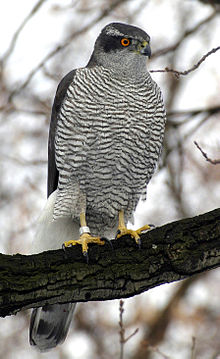Astur (genus)
| Astur | |
|---|---|

| |
| Eurasian goshawk (Astur gentilis) | |
| Scientific classification | |
| Domain: | Eukaryota |
| Kingdom: | Animalia |
| Phylum: | Chordata |
| Class: | Aves |
| Order: | Accipitriformes |
| Family: | Accipitridae |
| Subfamily: | Accipitrinae |
| Genus: | Astur Lacépède, 1799 |
| Type species | |
| Falco gentilis Linnaeus, 1758
| |
Astur is a genus containing hawks, goshawks and sparrowhawk in the family Accipitridae. The species were formerly placed in the genus Accipiter.
Taxonomy
[edit]The genus Astur was introduced in 1799 by the French naturalist Bernard Germain de Lacépède.[1] The type species was later designated by the Irish zoologist Nicholas Vigors as Falco palumbarius Linnaeus, 1758, now considered as a junior synonym of Falco gentilis Linnaeus, 1758, the Eurasian goshawk.[2][3] The name is from Latin astur, asturis meaning "hawk".[4]
Species now placed in this genus were formerly assigned to the genus Accipiter. Molecular phylogenetic studies found that Accipiter was polyphyletic and in the subsequent rearrangement to create monophyletic genera, the genus Astur was resurrected in 2024 to contain 9 species that were previously placed in Accipiter.[5][6][7]
The genus contains 9 species:[7]
- Cooper's hawk, Astur cooperii
- Gundlach's hawk, Astur gundlachi
- Bicolored hawk, Astur bicolor
- Chilean hawk, Astur chilensis
- Black sparrowhawk, Astur melanoleucus
- Henst's goshawk, Astur henstii
- Eurasian goshawk, Astur gentilis
- American goshawk, Astur atricapillus
- Meyer's goshawk, Astur meyerianus
References
[edit]- ^ Lacépède, Bernard Germain de (1799). "Tableau des sous-classes, divisions, sous-division, ordres et genres des oiseux". Discours d'ouverture et de clôture du cours d'histoire naturelle (in French). Paris: Plassan. p. 4. Page numbering starts at one for each of the three sections.
- ^ Vigors, Nicholas Aylward (1824). "Sketches in ornithology; or, observations on the leading affinities of some of the more extensive groups of birds (to be continued)". Zoological Journal. 1: 308–346 [326].
- ^ Sangster, G.; Kirwan, G.M.; Fuchs, J.; Dickinson, E.C.; Elliott, A.; Gregory, S.M.S. (2021). "A new genus for the tiny hawk Accipiter superciliosus and semicollared hawk A. collaris (Aves: Accipitridae), with comments on the generic name for the crested goshawk A. trivirgatus and Sulawesi goshawk A. griseiceps". Vertebrate Zoology. 71: 419–424. doi:10.3897/vz.71.e67501.
- ^ Jobling, James A. "Astur". The Key to Scientific Names. Cornell Lab of Ornithology. Retrieved 22 August 2024.
- ^ Mindell, D.; Fuchs, J.; Johnson, J. (2018). "Phylogeny, taxonomy, and geographic diversity of diurnal raptors: Falconiformes, Accipitriformes, and Cathartiformes". In Sarasola, J.H.; Grange, J.M.; Negro, J.J. (eds.). Birds of Prey: Biology and conservation in the XXI century. Cham, Switzerland: Springer. pp. 3–32. ISBN 978-3-319-73744-7.
- ^ Catanach, T.A.; Halley, M.R.; Pirro, S. (2024). "Enigmas no longer: using ultraconserved elements to place several unusual hawk taxa and address the non-monophyly of the genus Accipiter (Accipitriformes: Accipitridae)". Biological Journal of the Linnean Society: blae028. doi:10.1093/biolinnean/blae028.
- ^ a b Gill, Frank; Donsker, David; Rasmussen, Pamela, eds. (August 2024). "Hoatzin, New World vultures, Secretarybird, raptors". IOC World Bird List Version 14.2. International Ornithologists' Union. Retrieved 21 August 2024.

